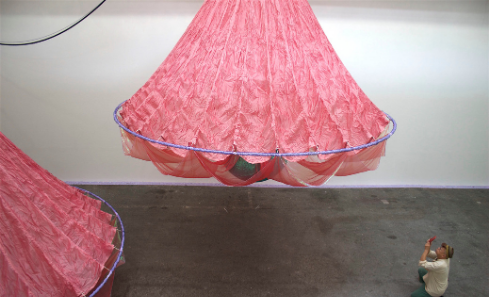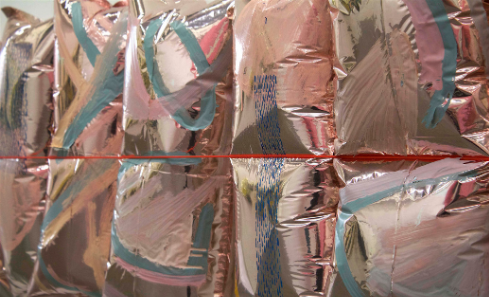
In 2018, the exhibition Hungry Ghost Engines took place at CASO in Osaka, Japan in October. It was developed by two artists: Arabella Hope and Silas Parry.
Now, the exhibition’s second iteration will be shown at Edinburgh’s Patriothall Gallery, from 4 - 19 May 2019.
We spoke to Silas to find out more.
Hungry Ghost Engines is a two person exhibition of sculptural installations created by Arabella Hope and myself. First shown at Contemporary Art Space Osaka in October 2018; the project is being be re-mixed for Edinburgh's Patriothall Gallery (opening 3 May, 7 - 9pm, exhibition runs 4 - 19 May).

Hungry Ghosts are a familiar form of Yōkai (a category of supernatural monsters, spirits and demons). In Japanese folklore, those consumed by greed and addiction in life will become hungry ghosts, condemned to an endless search for satisfaction in the afterlife.
This belief has increasing relevance for today’s world. Because what are capitalist economies but the creators of hungry ghosts? Our societies are fuelled by desire and self-interest. What drives this compulsion? And what are the consequences of consumerism?
In some ways UK and Japanese cultures couldn’t be further apart. Yet the similarities are striking – both island nations, both highly technological, and in both societies, human and animal relations are subsumed by mountains of cheaply made plastic toys, and floods of funny-kitten youtube videos.
There was lots to talk about. Arabella and myself each have an ongoing connection with Japan, and an ambiguous relationship to the hungry ghost engines. We both enjoy a playful use of materials, and a vibrant approach to colour. And we share a desire to critique our political, social and environmental choices with a cheeky grin rather than a wagging finger.

We’ve never collaborated before, and so HGE was a big learning curve. The most important element of this project has been communication - from those very first meetings, through producing the show, to its exhibition and subsequent return to Scotland.
Hungry Ghost Engines is the result of a thousand conversations between myself and Arabella, between ourselves and the Japanese gallery team, between the works on display. All of these words, gestures and signals were the glue that kept the project together.
We were invited to Contemporary Art Space Osaka (CASO) by curator and artist Yoshihito Kawabata, who is a leading figure in the experimental Clean Brothers organisation. In particular Clean Brothers are known for their work exposing emerging artists to a wider Japanese audience.
During my first visit to Japan in 2016 (for residency programmes Shiro Oni and Studio Kura), I hugely enjoyed meeting artists, gallerists and curators. And without a doubt my favourite of these connections had been set up by Arabella… the unforgettable Yoshihito welcomed me to a local Osaka basement-bar, and his reassuring grin kept me from panicking when an earthquake began seconds later.
So it was incredibly exciting when we were invited to exhibit at Yoshihito’s spectacular water-front white-cube gallery. Working with Yoshihito, Clean Brothers and the CASO team was a fascinating process. From those initial online meetings (through to detailed planning and eventually arriving at Kansai Airport) every stage gave us surprising - and often delightful - insights into the Japanese approach to art and life.
You can see images of HGE at CASO at https://hungryghostengines.com/
![]()

There’s something surreal and poetic about pouring so much time and thought into these works - then packing them up and seeing them re-appear (as if by magic) in a completely different context on the other side of the world.
It became even more powerful overseeing this operation in reverse, because it felt like the journey was just beginning. We’d always agreed the project should continue to evolve and develop after the Japanese experience… So I’m excited to see HGE reformulated on home shores.
Some of the works made for CASO are simply too big for Patriothall, so materials will be deconstructed and re-set for this new context. Many pieces will be recognisable, while others will be re-jigged to approach the same idea from a different direction. Works that didn’t make the final edit for shipping may also find their voice, pulling the show in subtly new directions.
HGE has been a mammoth journey. Patriothall will complete the circle and allow us to share some of things we’ve learnt – I’m especially looking forward to opening the project to a Scottish audience through the accompanying artist talks and discussions.
With Hungry Ghost Engines I tried to balance exuberant materials, unusual forms, and a conceptual foundation that makes people think. I’d like the exhibition to question the status quo without being judgmental. And I’d really love the audience to leave having experienced a genuine connection with the works.
For those who’d like to delve a little deeper into HGE, we’ll share our journey over a series of talks and discussions. These will cover the creative development of the project as well as the practical considerations that made it a reality. The discussions will help us reflect on the themes of the exhibitions... we’ve asked a lot of questions, have we found any answers?
Images: Silas Parry ‘Jellyfish Acid Karma’ 2018 - scale shot; Arabella Hope ‘Luft Balloons 2 2018, handmade and painted Mylar inflatables, rubber tubing; Silas Parry ‘Jellyfish Acid Karma’ 2018 - detail shot; Arabella Hope ‘All of our helium is escaping into space!’ 2018. Painted handmade Mylar inflatables. Courtesy of Silas Parry.